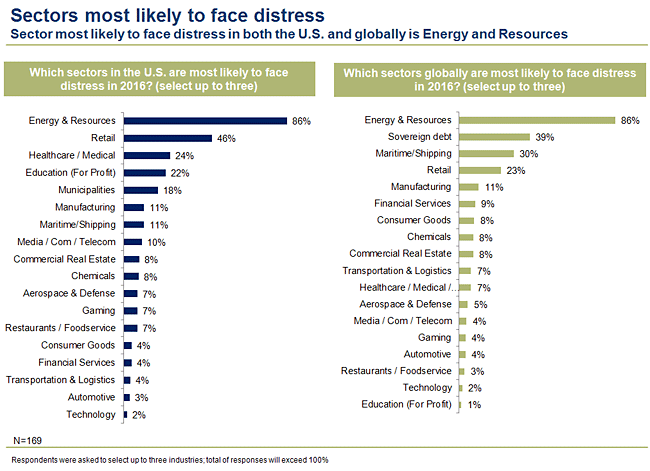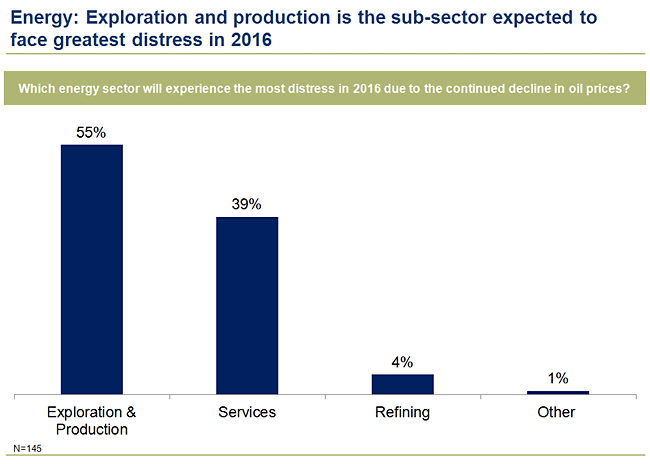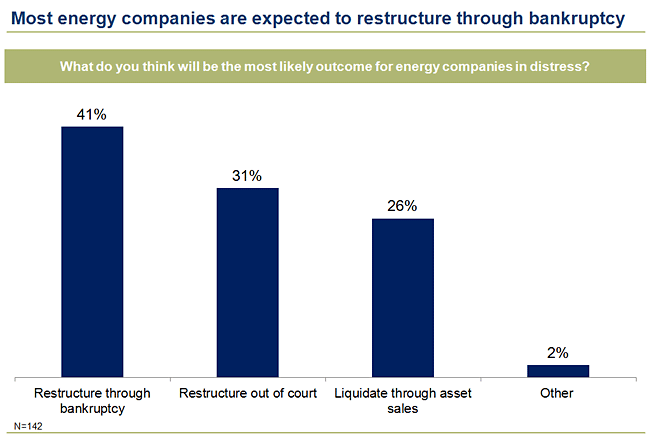
When the Federal Reserve raised interest rates at the end of 2015, it signaled an end to an era of historically low rates, a move that could presage an increase in corporate restructuring and bankruptcies as capital gets more expensive.
Our annual survey, which drew on 185 restructuring experts, including attorneys, investment bankers, lenders, financial advisors, hedge fund managers, and private equity investors, reveals strong industry belief that 2016 will see a rise in restructuring activity, and a continuation of the trend of more pre-negotiated and prepackaged bankruptcies.
While the decision to raise rates a quarter of a percentage point was long anticipated, subsequent commentary from Fed presidents suggests the pace of further increases remains uncertain. The Fed board’s consensus view that rates will likely end the year between 1.25% and 1.5%, however, may hasten the end of ultra-low-cost financing options used by heavily indebted, distressed companies to stave off bankruptcy filings and formal restructurings during the seven-year period of near-zero rates.
Eighty percent of survey respondents said low rates and easy financing have played a “significant” role in forestalling Chapter 11 filings, a situation many observers say may begin to change in 2016. If such a reckoning occurs, industry experts see many U.S. companies in the energy, retail, and healthcare industries as the most likely to pursue restructurings or file for bankruptcy. Globally, energy, sovereign debt, shipping, and retail lead the list of industries likely to be more vulnerable this year. There’s greater concern over sovereign debt than a year ago, as it moved up from fourth position in 2015 to second in 2016 survey (figure 1).
Figure 1: Which U.S. and global sectors are most likely to face distress in 2016?

The January 2016 equity market jitters over volatility in the Chinese stock market and commodity prices may add some credence to experts’ concerns over the ripple effects of the slowdown in the world’s second-largest economy. Nearly 75% of survey respondents believe China’s slowdown could have a “significant” or “moderate” effect on the number of U.S. restructurings this year.
China’s economic slowdown has contributed to the global imbalance in supply and demand, which has driven down commodity prices. Companies in the oil-and-gas and mining industries, for example, appear to be suffering from these lower prices. Steel and aluminum are two examples of industries that have pressure on their capital structures, because even though the costs of their raw materials have declined, in some cases the prices of their finished products have declined more.
Eighty-six percent of experts surveyed cited energy as the industry most likely to face distress in 2016. The experts’ forecast for 2016 is even more pessimistic than last year, when 78% of respondents saw energy as the industry most likely to face distress. Concerns are heightened by debt levels and over-capacity among energy companies already buffeted by plunging oil prices -- global benchmark Brent crude hit a 12-year low during the first week of 2016. (Read about this in the 2016 AlixPartners Oil and Gas Outlook)
The expiration of many financial hedge agreements, coupled with high leverage, may push some companies into restructuring. Just over half of the survey respondents—55%—said exploration and production companies would see the most distress from low oil prices in 2016. The services sector is the next most likely to see severe distress, said 39% of respondents (figure 2).
Figure 2: Which energy sub-sector is most likely to face distress in 2016?

Survey respondents expect distressed energy companies to seek a range of resolutions to their financial troubles. Global oversupply and waning demand from many emerging markets will continue to weigh on the U.S. energy industry, and bankruptcy is the most likely outcome, according to 41% of respondents. Another 31% suggested out-of-court restructurings would be the most common path, while 26% said distressed energy companies would be more likely to liquidate through asset sales (figure 3).
Figure 3: What is the most likely outcome for distressed energy companies in 2016?

Other Industries Facing Trouble in 2016
Retail was named the second-most-likely U.S. industry to face distress, though the percentage of respondents who placed it in among the three industries most likely to see distress dropped to 46%—down from 52% a year ago. Prepackaged and pre-negotiated bankruptcies are likely to play even greater roles in retail restructurings, likely driven by the 2005 changes to the federal bankruptcy code that effectively give most retailers only 210 days to file a bankruptcy plan of reorganization. (Read about this in the AlixPartners Retail Bankruptcy Insight)
Continued on Page 2...